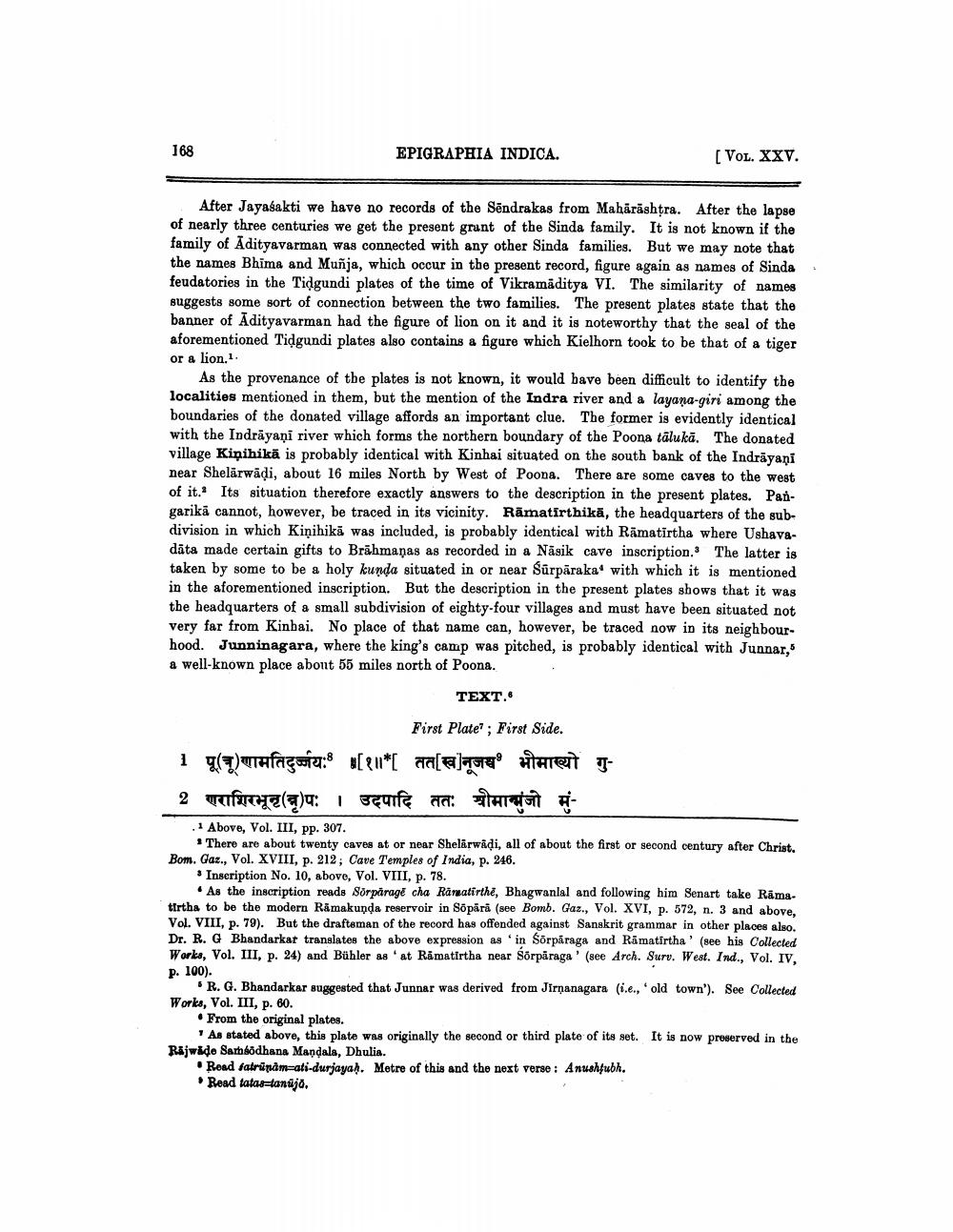________________
168
EPIGRAPHIA INDICA.
After Jayasakti we have no records of the Sendrakas from Maharashtra. After the lapse of nearly three centuries we get the present grant of the Sinda family. It is not known if the family of Adityavarman was connected with any other Sinda families. But we may note that the names Bhima and Muñja, which occur in the present record, figure again as names of Sinda feudatories in the Tidgundi plates of the time of Vikramaditya VI. The similarity of names suggests some sort of connection between the two families. The present plates state that the banner of Adityavarman had the figure of lion on it and it is noteworthy that the seal of the aforementioned Tiḍgundi plates also contains a figure which Kielhorn took to be that of a tiger or a lion.1.
[VOL. XXV.
As the provenance of the plates is not known, it would have been difficult to identify the localities mentioned in them, but the mention of the Indra river and a layana-giri among the boundaries of the donated village affords an important clue. The former is evidently identical with the Indrāyaṇi river which forms the northern boundary of the Poona taluka. The donated village Kinihika is probably identical with Kinhai situated on the south bank of the Indrāyaṇī near Shelarwaḍi, about 16 miles North by West of Poona. There are some caves to the west of it. Its situation therefore exactly answers to the description in the present plates. Pangarika cannot, however, be traced in its vicinity. Ramatirthika, the headquarters of the subdivision in which Kinihika was included, is probably identical with Rämatirtha where Ushavadāta made certain gifts to Brahmanas as recorded in a Nasik cave inscription. The latter is taken by some to be a holy kunda situated in or near Surpäraka with which it is mentioned in the aforementioned inscription. But the description in the present plates shows that it was the headquarters of a small subdivision of eighty-four villages and must have been situated not very far from Kinhai. No place of that name can, however, be traced now in its neighbourhood. Junninagara, where the king's camp was pitched, is probably identical with Junnar," a well-known place about 55 miles north of Poona.
TEXT."
First Plate; First Side.
1 पू(पू) णामतिदुर्जयः ॥ [* [ तत[व] नूजय भोमाख्यो गु
2
शिरभू (पः । उदपादि
ततः श्रीमानुंजो मुं
1 Above, Vol. III, pp. 307.
There are about twenty caves at or near Shelarwadi, all of about the first or second century after Christ. Bom. Gaz., Vol. XVIII, p. 212; Cave Temples of India, p. 246.
Inscription No. 10, above, Vol. VIII, p. 78.
As the inscription reads Sorparage cha Ramatirthe, Bhagwanlal and following him Senart take Ramatirtha to be the modern Rämakunda reservoir in Söpärä (see Bomb. Gaz., Vol. XVI, p. 572, n. 3 and above, Vol. VIII, p. 79). But the draftsman of the record has offended against Sanskrit grammar in other places also. Dr. R. G Bhandarkar translates the above expression as in Sōrpäraga and Rämatirtha' (see his Collected Works, Vol. III, p. 24) and Bühler as at Ramatirtha near Sörpäraga' (see Arch. Surv. West. Ind., Vol. IV, p. 100).
R. G. Bhandarkar suggested that Junnar was derived from Jirṇanagara (i.e., old town'). See Collected Works, Vol. III, p. 60.
From the original plates.
As stated above, this plate was originally the second or third plate of its set. It is now preserved in the Rajwade Samsodhana Mandala, Dhulia.
Read satrunam-ati-durjayah. Metre of this and the next verse: Anushfubh. Read tatas tanújo.




